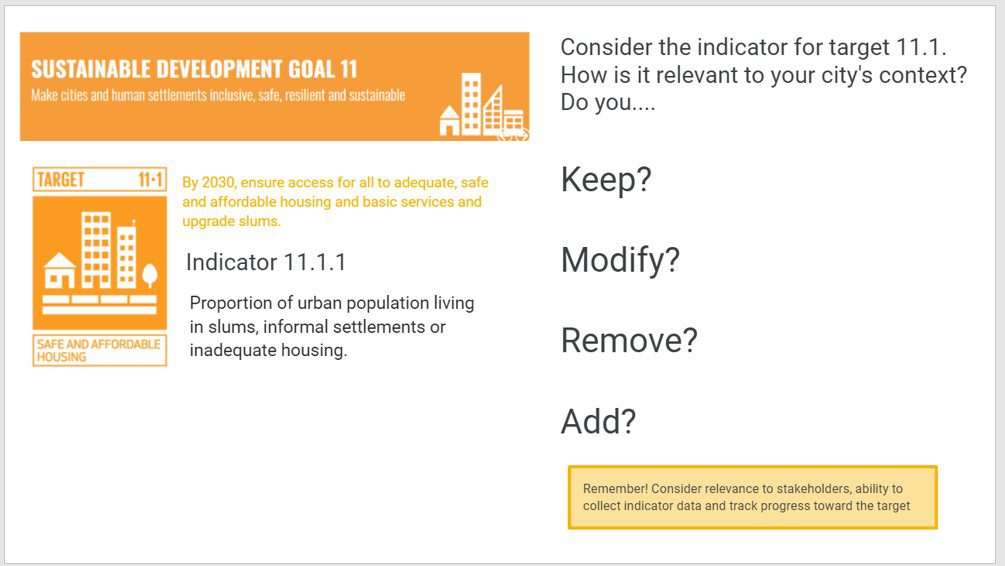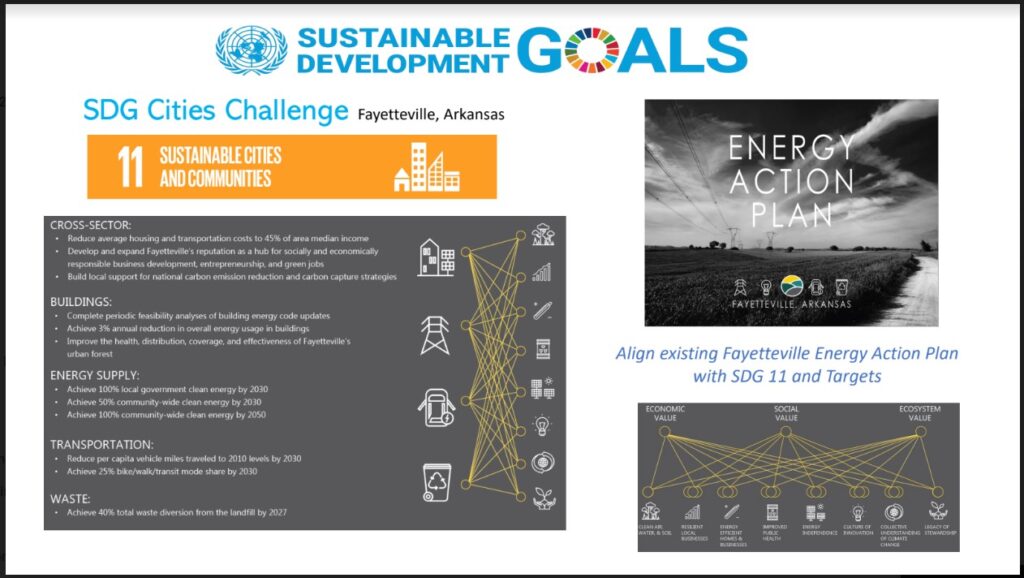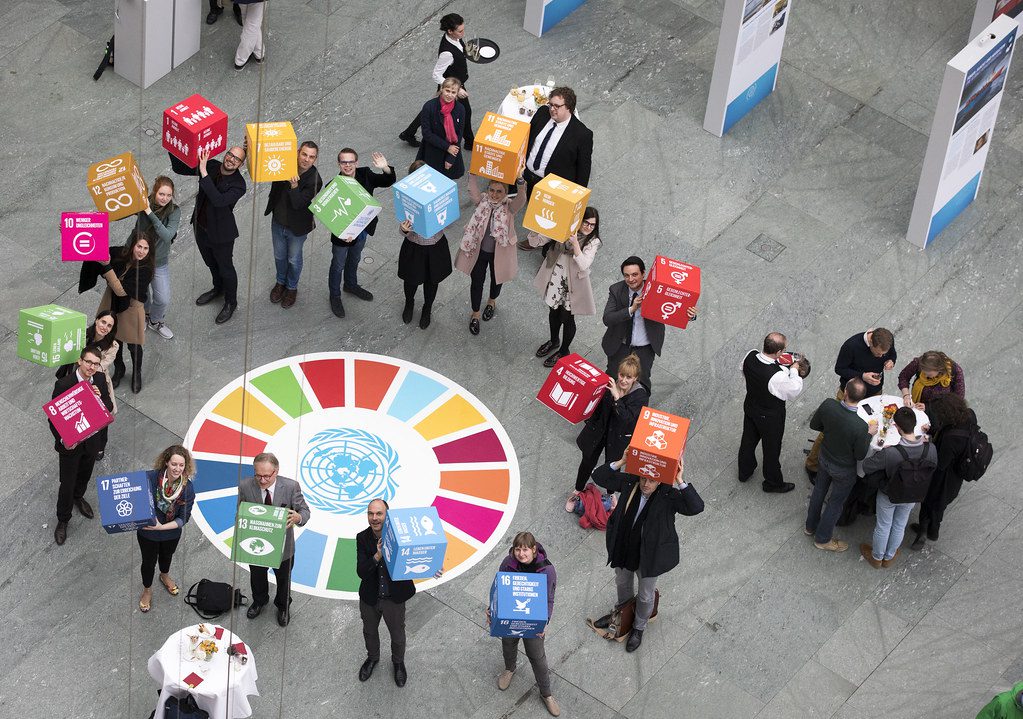This blog post is co-written by Kale Roberts, Senior Program Officer, ICLEI USA, and Dr. Cathy Oke, Enterprise Principal Fellow in Informed Cities, University of Melbourne. The featured image is an exhibition about the SDGs in Berlin, Germany. Image: Inga Kjer / photothek.net, CC BY-ND 2.0.
When the United Nations unveiled the 2030 Agenda in 2015, it gave the world a framework for holistic sustainable development but also an assertive 15-year timeline. The Sustainable Development Goals (SDGs) are a blueprint for a thriving planet where no one is left behind. The 17 Global Goals expand on a people-planet-prosperity model to address issues as seemingly disparate, but ultimately interconnected, such as gender equality, sustainable consumption and production, climate action and peace.
Seven years later, the UN’s High-Level Political Forum (HLPF) — hosted last month in New York City as the latest installment in an annual series that tracks SDG progress — proved that the SDGs are a useful recovery framework for a world wracked by COVID, economic recession, and conflict. Nations have largely made the SDGs their own with only six countries yet to have presented at least one Voluntary National Review (VNR) of their SDG progress. Yet, the quality of these VNRs is greatly uneven, and huge data gaps prevent confidence in knowing where we, as a world, truly stand toward achieving the goals. Unfortunately, we can say with great confidence that we are not presently on track to meet success. Or as U.N. Secretary-General António Guterres wrote: “We need an urgent rescue effort for the SDGs.”
However, the HLPF also proved that the intended “users” of the 2030 Agenda have evolved over time, with cities and regions at the forefront of taking SDG action on the ground. It may be at the local level where the story is a bit brighter. Since 2018, when New York City and a group of Japanese cities took the pioneering steps to publish the first “Voluntary Local Reviews” (VLRs) of the SDGs, nearly 100 cities and regions around the world have published their own SDG progress reports.
Data-driven and people-centered, a generation of VLRs is drawing on cities’ closeness to where sustainable development happens at the ground level to bring greater clarity — and community-level ownership — to the Global Goals. And the SDGs Cities Challenge is among the initiatives accelerating this local update, action, and reporting.
What is the SDGs Cities Challenge?
Eight communities spanning the United States — Atlanta, Georgia; Dallas, Texas; Denton, Texas; Fayetteville, Arkansas; Maui County, Hawai’i; New Haven, Connecticut; Orange County, Florida; and San Antonio, Texas — engaged in a group leadership-and-learning experience known as the SDGs Cities Challenge.
Delivered in partnership between ICLEI USA, University of Melbourne’s Centre for Cities, and the University of Texas at Arlington, with knowledge partnership from Brookings Institution, and support from the Tomberg Family Philanthropies, “the Challenge” the second year of the initiative — and brought the program to the United States for the first time.
Across six months in 2021, these pioneers of local SDG action came together in a series of peer-learning sessions that kicked off during the HLPF 2021 with scene-setting remarks from the New York City Mayor’s Office for International Affairs (developer of one of the first VLRs), UNHABITAT, the Brookings Institution, and City of Orlando. Sessions offered training and discussion space on cross-departmental collaboration, developing data dashboards, finance and more.

The SDGs Cities Challenge oriented participants around three primary themes:
Whole-of-government approaches. Cross-departmental engagement accelerates sustainability leadership as does community engagement from a wide breadth of stakeholders Aissata Camara, Deputy Commissioner for Operations and Strategic Partnerships, New York City showed how NYC took a “city tour” approach to collect information neighborhood by neighborhood as well as draw on a youth corps, which offers innovative learning opportunities for youth in UN projects.
Data. Baseline data tells a community where they currently stand on each SDG indicator. Erin Bromaghim, Director of Olympic and Paralympic Development, City of Los Angeles, showed the cohort how to take LA’s open-source SDG data dashboard and make it their own, while Kaimana Bingham, Aloha+ Dashboard and Partnerships Manager, Hawai’i Green Growth, demonstrated the power of Hawai’i’s statewide SDG dashboard for aggregate metrics from governments, business and nonprofits across the islands.
Budgeting for SDG impact. The SDGs can offer the city a framework for using their spending dollars for good. Frida Gothnier Leander, Sustainability Strategist, City of Malmö, showed us how the Swedish city engaged in a multi-year budget realignment exercise. Sandi Vidal, Vice President of Community Strategies and Initiatives at the Central Florida Foundation showed the power of philanthropy to achieve progress when a funder’s giving portfolio is SDG-aligned, and Grant Ervin, Sustainability Manager, City of Pittsburgh, showed how the City’s VLR serves as a sustainable public procurement policy aimed at integrated SDG considerations into all government purchasing.
While these case stories provided practical guidance, they were also meant to inspire each participant to define their own “SDG challenge”, which they would begin to implement as part of the cohort. Challenges were self-determined and needed to address a minimum of one Global Goal. During the final session, the eight communities presented posters outlining their initiatives:
- Atlanta, Georgia – Create an SDG2-aligned food policy that builds equity into a sustainable food system
- Dallas, Texas – Create an SDG7-aligned Energy Plan that better accounts for the equity benefits of solar installations through home weatherization programs
- Denton, Texas – Create SDG7-aligned equity in energy rebates and weatherization program
- Fayetteville, Arkansas – Reimagine Energy Action Plan to incorporate SDG 10 reduced inequalities
- Maui County, Hawai’I – Develop an SDG-aligned data-gathering and reporting framework used by all government departments
- New Haven, Connecticut – Develop an SDG2-focused Zero Hunger Plan for the City
- Orange County, Florida – Use SDG15 – Life on Land – a central tenet of government planning, beginning with climate planning but eventually bringing biodiversity considerations into all government work
- San Antonio, Texas – Develop a whole-of-government approach to sustainability and develop a Voluntary Local Review of the SDGs

Why the SDGs Matter for Local Governments: Lessons from the SDGs Cities Challenge
Envisioned primarily as a framework to be used by nations, the SDGs offer a set of targets and indicators that are also relevant for cities, towns, counties and regions — if local governments take steps to adopt them, making each goal and target their own. Through the engagement, a number of lessons emerged.
First, SDGs Cities Challenge participants learned that the process of “localizing” the SDGs offers a unique value proposition, including:
- Engaging their community in a global conversation on sustainability
- Opening connection to peer cities in the SDGs Cities Challenge cohort as well as the worldwide community of cities that have issued VLRs
- Offering an approachable framework with recommended targets and indicators for holistic sustainable development
- Strengthening cross-department data and communications
- Fostering multi-level action that builds connections between local, state, national, and international governments
- Giving a blueprint for the post-COVID economic recovery effort
Second, no two cities undertook the same project — which is indicative of the diversity of actors involved in each city, their varying department structures, political climates, and other factors. However, there do appear to be two or three “types” of projects undertaken during the Challenge: some cities (or counties) look to embed the goal(s) into high-level planning documents (e.g., New Haven’s Comprehensive Plan approach), while other cities chose to focus on an existing or new initiative or program to generate most impact (e.g., Dallas’ and Denton’s Weatherization program). We also saw SDG-inspired data dashboards for tracking progress across city departments and local stakeholders (this may be inspired by the two dashboards from Los Angeles and Hawai’i presented as part of the Challenge).
Third, partnerships are crucial to implementing any SDG project, as well as for the Challenge itself. For example, the University of Texas at Arlington recruited Texas local government participants. University partnerships could be expanded for future cohorts.

Scaling the SDGs Cities Challenge
A final lesson from the SDGs Cities Challenge is that its scalable model, interest from a wide diversity of cities, and opportunities for on-the-ground impact is ready to be scaled. ICLEI, the University of Melbourne, and other partners are interested in supporting a global expansion of the program as a primary mechanism to put the SDGs back on track.
A global SDGs Cities Challenge, structured as multiple concurrent, technical support cohorts operating through 2030, would reach most of ICLEI’s 2,500 cities, towns and regions, and be supported by a network of university and thought leadership partners. This effort could serve as a VLR preparatory facility or otherwise link to countries’ Voluntary National Reviews, bringing greater data clarity and community connection.
If you are interested in bringing the SDGs Cities Challenge to your community, or partner with ICLEI and the University of Melbourne to expand the program, contact kale.roberts@iclei.org.
Kale Roberts is a Senior Program Officer at ICLEI USA, where he provides U.S. cities with technical support on climate, resilience, and sustainability action. He serves as advocacy lead, connecting U.S. communities to the United Nations’ processes on climate, nature, and land use.
Dr. Cathy Oke is Melbourne Enterprise Principal Fellow in Informed Cities in the Faculty of Architecture Building and Planning and Associate Director (Enterprise and Impact) for Melbourne Centre for Cities. Cathy’s research interests focus on the interaction between urban nature and climate – research, policy and practice – for greater impact in cities. She is project leader of the SDGs Cities Challenge, Senior Advisor to the Innovate4Cities program of the Global Covenant of Mayors for Climate and Energy and sits on ICLEI’s (Local Governments for Sustainability) Global Executive Committee. Cathy was a Councillor at the City of Melbourne 2008 – 2020.
